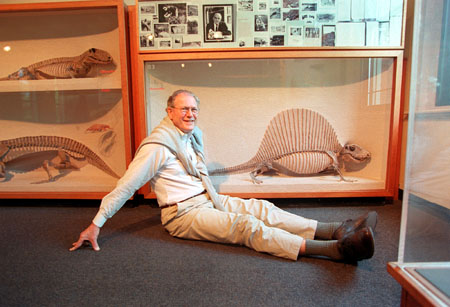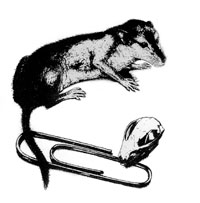Oldest mammal is found:
Origin of mammals is pushed back to 195 million years


Discovery of the skull of a shrewlike animal the size of a paper clip pushes back the origin of mammals, including humans, to 195 million years ago. Found in China, the tiny skull shows evidence that the first mammals evolved from reptiles 45 million years earlier than widely believed.
“Previously, the remains of the first true mammals were only found in deposits 150 million years old,” significantly younger than the newly discovered skull, notes Alfred Crompton, Fisher Research Professor of Natural History at Harvard University.
From 195 million to 150 million years ago, dinosaurs ruled the land. Scampering around their feet were platoons of diminutive insect-eating animals, part reptile, part something new. When a meteor strike or some other unknown calamity wiped out the giant reptiles and many other animals some 65 million years ago, the shrewlike newcomers prospered. They began evolving into different types of mammals and eventually gave rise to everything from field mice to elephants, whales, and humans.
“As the New Testament says, the meek shall inherit the Earth,” Crompton comments.
The meek creature has been named Hadrocodium wui, and its discovery is reported in the May 25 issue of the journal Science by Zhe-Xi Luo of the Carnegie Museum of Natural History in Pittsburgh; Crompton; and Ai-Lin Sun, formerly of the Institute of Vertebrate Paleontology and Paleoanthropology in Beijing
The new fossil was found in Yunnan Province in southern China more than 10 years ago. Ai-Lin Sun brought it to the United States when she came to Harvard as a visiting professor. Nothing much happened to the little skull, securely encased in rock, until William Amaral of Harvard’s Museum of Comparative Zoology carefully freed the skull from its rock entombment. Zhe-Xi Luo did a major analysis of the skull. Based on his work, the three scientists concluded that H. wui either is, or is very close to being, the oldest known true mammal and a missing link between reptiles and mammals.
New jaws, ears, teeth
The little almost-mammal weighed a scant 2 grams, considerably less than an ounce. Crompton suspects that it was warm-blooded and possessed hair, although that cannot be proven. H. wui probably was too small to eat anything but insects. It was, in turn, eaten by lizards and other reptiles. According to the accepted definition, mammals have three linked bones in the middle ear, part of the apparatus that translates vibrations of the air into nerve signals that register as sound in the brain. H. wui has these bones, which are believed to have once been part of the jaws of reptiles.
Mammals are also defined by a lower jaw consisting of a single bone that both holds teeth and forms a joint with the upper jaw. In contrast, reptiles have many bones in their lower jaws, some of which make up the jaw joint. A series of fossils, dating back 200 years, show these latter bones becoming smaller and smaller. Paleontologists believe these bones eventually migrated to the middle ear, but until now, no good evidence of this existed. H. wui fills this gap and shows that we hear with bones that once formed part of the jaws of reptiles.
“Bones probably could not migrate from the jaw to the middle ear unless the animals were very small,” Crompton points out.
Also, H. wui’s teeth are less like those of reptiles and more like those of mammals. Lizards, snakes, dinosaurs and other reptiles replace their teeth numerous times throughout their lives. Mammals, including humans, start with milk, or baby, teeth, replacing them with permanent incisors, canines, and molars as their skulls grow.
This difference reflects lifestyle. Immediately after they hatch, reptiles need to start feeding on solid food. Then they replace their teeth numerous times as their bodies grow larger. Mammals, as their name indicates, take their first nourishment from their mothers’ mammary glands. Considerable cranial growth occurs before it becomes necessary to replace the milk teeth.
Teeth in the H. wui skull suggest that this animal suckled its young and, thus, is a true mammal, Crompton notes.
However, he and his colleagues are cautious about making claims for H. wui’s position on the evolutionary ladder. “Not everyone will agree with our interpretation that the skull represents the oldest relative of mammals, a species that lived as long ago as 195 million years,” he admits. There will be controversy until more fossils like it are found in rocks as old.
Skull search
A few isolated teeth of animals thought to have been part of the reptile-mammal transition were found in the 19th century. By the 1940s, however, such teeth began to appear in larger numbers.
Crompton tells the story of a German refugee named Walter Kuhne, who at the start of World War II walked into Cambridge University with teeth from a borderline mammal. “I know where to discover early mammals,” he told British paleontologist F.R. Parrington. Parrington was impressed enough to offer him £5 (about $35 then) for every additional tooth he brought to the university.
World War II delayed the search. But in 1948, Kuhne found a limestone formation in England laced with deep fissures caused by water dissolving away the stone. These fissures served as natural traps into which fell thousands of teeth and skull fragments of animals related to H. wui.
“That was the beginning of the latest surge of interest in the origin of mammals,” Crompton says.
Skulls from the critical reptile-mammal transition also began showing up in China. In 1948, a young Roman Catholic priest, Father Oehler, found one such skull. The priest knew it was important, and he later claimed the find of the fossil kept him going while in prison during the Chinese revolution. The skull was not examined and reported until 1973 by Ai-Lin Sun and her co-workers.
Sun went to the site where Oehler had found the fossil and discovered more complete skulls, which she brought to Harvard. Crompton and his colleagues at the Museum of Comparative Zoology also found such skulls in North America, Greenland, and South Africa.
That evidence shows that many small species evolved toward the mammal state some 300 million years ago, but most of them died out. “It appears that only one group successfully crossed the reptile-mammal divide,” Crompton comments. The skull that Ai-Lin Sun brought to Harvard represents that group, and provides evidence that a true mammal dodged dinosaur feet and ate bugs as long as 195 million years ago.




